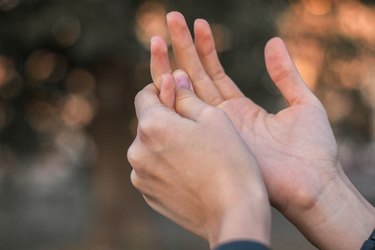
A broken finger can preclude you from certain activities and make your daily life awkward, from driving to sending a text message. But provided you stick to the proper guidelines and follow the advice of your doctor, you can at least keep working out with a broken finger.
Upper- and Lower-Body Workout
Video of the Day
Experienced a broken finger recently? You're not alone. Fracture rates have increased by 11 percent from 20 years ago, and age-related fractures are projected to increase across the nation from 2.1 million in 2005 to more than 3 million by 2025 as the population ages, according to a March 2014 study in Journal of Bone and Mineral Research. But for fitness enthusiasts, you don't need to sit out your entire workout — you can still exercise with a broken finger.
Video of the Day
You might find that an upper body workout with a broken finger is quite difficult when you start. However, depending on the severity of your pain, you could try specific exercises that don't use too much grip strength. According to an October 2014 study in BMC Musculoskeletal Disorders, grip strength correlates with injuries in hands. Exercises you can try include the following:
- Chest-press machines with open palms.
- Shoulder-press machines with open palms.
- Abdominal crunches.
- Body weight exercises like split squats and standing and walking lunges.
- Cardiovascular training. Your cardio routine should remain relatively unaffected by your broken finger, unless you prefer biking or rowing that requires gripping a bar. Outdoor activities like walking and jogging shouldn't cause your finger any issues either. If you'd prefer to spice up your cardio training, try playing a sport like soccer that doesn't involve much use of your arms.
You should avoid certain exercises with an injured finger, such as the following:
- Any strength-training exercises that use grip strength, which include upright rows or pull-up variations and barbell and dumbbell exercises.
- Cardiovascular exercises like biking and rowing that involve tight grip strength.
- Avoid push-ups as this move requires your hands to carry a lot of weight.
Rehab Your Broken Finger
Once your doctor OKs it, you can perform specific strengthening movements for your finger, as this body part likely experienced a degree of atrophy while you healed. The American Academy of Family Physicians (AAFP) recommends the following exercises:
- Range of motion: Use your uninjured hand to straighten out and bend the injured finger. Stop immediately if you feel pain.
- Grip strengthening: Make a fist with the hand that has the injured finger (or you can squeeze a stress or tennis ball).
- Finger extension: Put your hand with the injured finger flat on a table and try lifting up the finger.
- Picking up an object: Use the injured finger to pick up small objects like coins using the finger and thumb.
- Do activities using your fingers: Try writing or tying your shoes.
The AAFP notes that you might not be able to complete all these exercises, and you should always speak to your doctor first. You also shouldn't self-diagnose your injury.
Each injury is different and you can't predict exactly when you'll get back to your usual workouts. When you speak with a doctor, be sure to ask when you can expect to see improvements, what you should do if you feel worse and what daily activities should you avoid when you're still healing.
- American Academy of Family Physicians: “Exercising Your Finger After an Injury”
- Journal of Bone and Mineral Research: “Trends in Fracture Incidence: A Population‐Based Study Over 20 Years”
- BMC Musculoskeletal Disorders: "Grip Strength Ratio: A Grip Strength Measurement That Correlates Well With DASH Score in Different Hand/Wrist Conditions"
- American Academy of Family Physicians: “Exercising Your Finger After an Injury”
- Journal of Bone and Mineral Research: “Trends in Fracture Incidence: A Population‐Based Study Over 20 Years”
- BMC Gastroenterology: "Prevalence and Risk Factors of Asymptomatic Colorectal Diverticulosis in Taiwan"
- BMC Musculoskeletal Disorders: "Grip Strength Ratio: a Grip Strength Measurement that Correlates Well with DASH Score in Different Hand/Wrist Conditions"
Is this an emergency? If you are experiencing serious medical symptoms, please see the National Library of Medicine’s list of signs you need emergency medical attention or call 911.